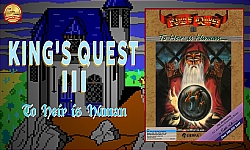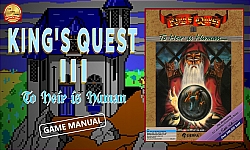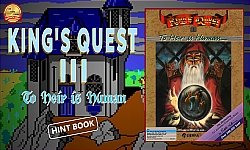|
Release: October 1, 1986.
Developer: Sierra On-Line.
Publisher: Sierra On-Line.
Designer: Roberta Williams.
Programmers: Al Lowe, Bob Heitman, Bob Kernaghan.
Artists: Doug MacNeill, Mark Crowe.
Writers: Roberta Williams, Annette Childs.
Composer: Margaret Lowe.
Series: King's Quest.
Engine: AGI.
Platforms: MS-DOS, Apple II, Apple IIGS, Amiga, Atari ST, Mac, Tandy Color Computer 3.
Category: Adventure.
Genre: Adventure.
Input: keyboard.
Mode: Single player.
King’s Quest III: To Heir Is Human is the third installment in the King’s Quest series of graphic adventure games developed and released by Sierra On-Line in
1986. The game was originally released for the Apple II and PC DOS, and later ported to several other computer systems. It was the first title game in the
series not to feature King Graham as the player character.
King Graham and Queen Valanice had two children, Alexander and Rosella, and the kingdom was once peaceful. It wasn’t long until Alexander was snatched from his
crib and things started to take a turn for the worse. A three-headed dragon threatens the ever-peaceful Daventry, and requires a maiden to be sacrificed every
year. Rosella is the chosen one. Meanwhile, in a secluded house atop a mountain in the land of Llewdor, the evil wizard called Manannan keeps a young lad named
Gwydion as his slave, forcing him to do menial tasks as he prepares his spells and observes the country through his telescope. Gwydion must find a way to
outsmart the wizard, escape, and eventually discover the truth about his own identity.
King’s Quest III works on a real-time clock, which is displayed at the top of the screen. This is important for tracking Manannan’s location, because he takes
journeys in roughly half-hour cycles. When he’s away, it’s a race against the timer to collect all of the items you need, store them in some place he won’t find
them, and make sure to cover your tracks so he can’t tell that you’ve been mucking around in his room. It’s a remarkably tense experience, even though it can
get quite frustrating if you take too long and inadvertently get caught.
Creating spells is also a gigantic hassle. In addition to the numerous items you need to create the half-dozen or so magic spells, you need to use them in the
precise order and speak a number of enchantments. The spells partially served as a form of copy protection, although the game already had disk-based protection.
Since the original release is entirely text-based, you need to type in each and every one of these commands – if you forgot to get an item or make a typo (even
a misplaced comma), you’ll screw up the process and inflict some comical ailment on yourself, triggering a Game Over. Not all of the spells are necessary, but
some of them allow for alternate puzzle solutions. Of course, once you leave Llewdor there’s no way to create any more spells, so this is an easy way to mess up
your game.
Once you’ve finally gotten rid of Manannan, the game leads you to stumble on its twist – that Gwydion is actually the long-lost son of Graham and Valanice, who
had been kidnapped in his youth. An oracle tells him of his twin sister Rosella, who has been kidnapped by a three headed dragon, so Gwydion signs up with a
group of pirates to take him back to the land of Daventry to save the kingdom and become reunited with his family. It’s here that King’s Quest III mostly drops
its adventure game pretenses and instead turns completely linear, as you navigate a series of mountain paths to find your way to the dragon’s lair. This
generally involves walking along narrow paths or climbing over rocks, always the most clumsily implemented aspects of Sierra’s AGI games. The first part of the
game is fairly strong, so it’s a shame that it ends up on such an annoying note.
|


